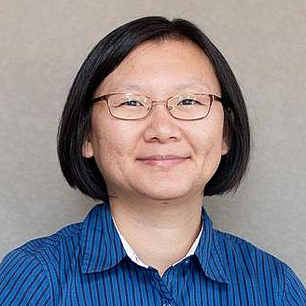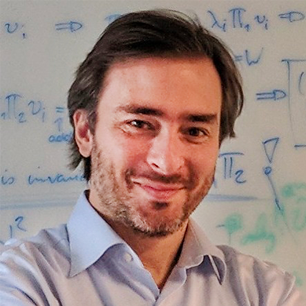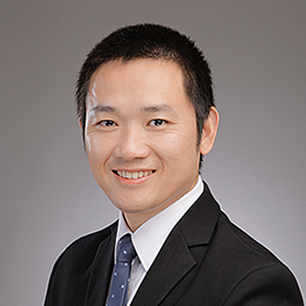
Dr Joe Fitzsimons
Chief Executive Officer
Bio
Driven by the vision of quantum computing as a revolution in computing technology, Joe quit his tenured faculty position to found Horizon Quantum Computing in 2018. Drawing on over 15 years’ experience in quantum computing and computational complexity theory, today he fully dedicates his time to Horizon with the goal of making quantum computing a general purpose computing technology capable of addressing some of the world’s most challenging computational problems.
Joe received a BSc in Theoretical Physics from University College Dublin and a DPhil from Oxford, where he went on to become a fellow of Merton College. Prior to founding Horizon, he led the Quantum Information and Theory group at Singapore University of Technology and Design, where he was a tenured associate professor, and was a principal investigator at the Centre for Quantum Technologies. He has published at the highest levels in both theoretical computer science (FOCS, STOC, CCC, ITCS) and physics (Science, Nature Physics, Physical Review Letters, Physical Review X), and has been named as a National Research Foundation Fellow and to the MIT Technology Review Innovators Under 35 Asia list.
Title
Abstracting Quantum Computing
Abstract
Quantum computers have the potential to drastically outperform conventional computers for a variety of tasks, from simulating molecular interactions to machine learning. However, our understanding of how to construct non-trivial quantum algorithms is still in its infancy and human intuition is not well suited to finding ways to accomplish computational tasks through quantum interference. As a result, reaching a future where quantum computing is widely used requires not only overcoming the challenges of building scalable quantum computers, but also finding new ways to program these systems to tackle new and more complex problems.
In this talk I will introduce some of the work we have been doing at Horizon Quantum Computing to simplify the task of programming quantum processors through increasing levels of abstraction, and discuss progress towards our goal of compiling classical code to take advantage of quantum processors, through automated synthesis of quantum algorithms.

Morris Huang Director,
of Research at QuDoor
Bio
Morris Huang, Director of Research at QuDoor Technologies, Inc., the first company in Asia dedicated to “atomic-type quantum computer, quantum secured communication and quantum internet”, AbaQ Is the first-generation distributed trapped ion quantum computing prototype.
Over 15 years experience in quantum technology and related fields, Mr. Huang received his PhD from Peking University with major in optics. Later, he worked as postdoctoral researcher in the quantum information group at the department physics at Lund University, Lund, Sweden, also in National Center for Nanoscience and Technology, China. Over his academic career, Mr. Huang published over 20 highly cited scientific papers on nonlinear optical, vibration noise analysis in atom and quantum information. Fueled by the passion of applying laser in various practical fields. Mr. Huang once said, “My work in life is one thing, and one thing only, that is constantly hitting smaller and smaller physical objects with lasers.” He joined QuDoor with focus on the development of distributed trapped ion quantum computer.
Title
Qudoor and Quantum Internet in China
Abstract
As the development of quantum computers by industry evolve dramatically, the roadmap towards to quantum supremacy of quantum computers come in a variety of forms. While scalable quantum computers are currently under development, smaller quantum devices and quantum terminals are currently available in practice. Based on this fact as well as the rich experience of developing QKD network in mainland China, the development of the scalable distributed gate‑model quantum computers based on quantum internet has already been warmed up in China, mainly led by our start-up company Qudoor, with a primary aim to provide unconditional security with advanced distributed quantum. Especially, we focus on quantum computers based on trapped atomic ions and scattered photons to provide a promising way to build a large-scale quantum information processor. Individual ions act as perfect qubits that have unsurpassed levels of quantum coherence. Meanwhile, enhancement of the collection of spontaneous emitted photons is likely to help scaling up an atom–photon quantum network. I will summarize several projects implemented by Qudoor and other colleague companies in mainland China, who are together motivated to build a new industry alliance named as “quantum optoelectronics”.

Patty Lee
Chief Scientist, Technology Development, Quantinuum
Bio
Patty Lee is the Chief Scientist of Technology Development at Quantinuum, where she leads the technology roadmap efforts to scale up trapped ion quantum computers. She received her PhD in physics from University of Michigan in Ann Arbor, where she developed phase control techniques for quantum logic gates in trapped ions. Prior to joining Honeywell, she worked as a research scientist at the National Institute of Standards and Technology, US Army Research Laboratory, and Lockheed Martin. Since joining Honeywell in 2016, her work has focused on the quantum charge-coupled device (QCCD) architecture for trapped ion quantum computers. In 2021, Honeywell Quantum Solutions combined with Cambridge Quantum to form Quantinuum.
Title
High Performance Commercial Trapped Ion Quantum Computers based on the QCCD Architecture
Abstract
Honeywell Quantum Solutions and Cambridge Quantum recently joined forces to form Quantinuum, a full-stack quantum computing company. Quantinuum's H-series trapped ion quantum computers, Powered by Honeywell, are designed around the quantum charge-coupled device (QCCD) architecture. By applying fast transport operations to reorder and position ion qubits across multiple trapping zones simultaneously on the device, the QCCD architecture creates a fully-connected, high fidelity, and scalable quantum computer. These systems offer the unique capability of performing conditional quantum operations dependent on mid-circuit measurement outcomes, and qubits can be re-used in the same circuit after measurements. This feature allows users to perform efficient quantum simulations and execute repeated cycles of quantum error correction, which was demonstrated for the first time on System Model H1. Recently, the H1 system became the first quantum computer to pass the quantum volume 1024 benchmark, the largest quantum volume ever measured on a commercial quantum computer. Future generation systems will incorporate new technologies such as 2D trap architectures and integrated photonics, in order to scale the number of physical qubits and further increase system performance.

Simone Severini Director
Quantum Computing Amazon Web Services
Bio
Simone Severini is a professor of Physics of Information at University College London, and the Director of Quantum Computing at Amazon Web Services (AWS). Simone contributed to start AWS’s effort in the space, which includes Amazon Braket, the quantum computing service, the AWS Center for Quantum Computing R&D organization, and the Amazon Quantum Solutions Lab.
Title
Ten Things to Know About Quantum Computing at AWS
Abstract
Simone Severini, Director of Quantum Computing at AWS, will discuss the AWS vision for Quantum Computing and highlight 10 key insights from the past year operating Amazon Braket as a fully-managed quantum computing service in the cloud. Simone will cover new features of Amazon Braket, research activities at the recently-opened Amazon Center for Quantum Computing at Caltech, and other innovations from across AWS's quantum computing team.

Steve Brierley
Founder and CEO, Riverlane
Bio
Steve is founder and CEO of Riverlane, which is a building the common Operating System for all quantum computers. He founded the company in 2016 because of his passionate belief that quantum computers capable of accelerating an era of human progress as significant as the industrial and digital revolutions could be created far sooner than previously imaginable. Today, Riverlane is well on its way to achieving that mission. Steve has worked in quantum for 20 years, is an expert advisor to the UK government. He has a PhD in mathematics and has worked as a research fellow at the University of Cambridge amongst other institutions.
Title
Getting to useful quantum computing sooner
Abstract
Quantum computing is an amazing idea that has the potential to transform computation. I’ll talk about why that is the case with some examples and how we are using systems engineering at Riverlane to realise this huge potential.

Xian-Min Jin
Founder and CEO, TuringQ
Bio
Xian-Min Jin is the founder and CEO of TuringQ, a professor at Shanghai Jiao Tong University (SJTU) and the director of Center for Integrated Quantum Information Technologies (IQIT). He received Ph.D. degree from University of Science and Technology of China (USTC) in 2008. After two-year postdoctoral research, he worked as a research associate at University of Oxford from 2010 to 2014, and was awarded Marie Curie Fellow and Wolfson College Fellow in 2012. He joined SJTU in 2014 and was promoted to a tenured full professor in 2019. His interests cover a broad spectrum ranging from quantum computing, quantum communication and quantum metrology with special focus on the subject of building large-scale quantum systems, via integrated photonics and quantum memory. He has published over 80 peer-reviewed journal papers listed in SCI, including 16 in Physical Review Letters, 2 in Science, 3 in Science Advances, 7 in Nature Photonics, 1 in Nature Physics, 3 in Nature Communications, and 6 in Optica, and more than 4000 citations with an H-index of 31.
Title
Photonic chip for scalable quantum information processing
Abstract
Photon can be generated, manipulated and detected comparatively easier than other quantum particles, and can be transferred in a long distance without coupling with environment. Photon therefore is a promising candidate for realizing quantum information processing. However, the limitations of bulk optics have become key bottleneck preventing quantum technologies from realizing in practice. Alternatively, integrated photonics provides an elegant way to scale up quantum systems. In this talk, I will present our endeavours on CMOS compatible LNOI programmable photonic chip, femtosecond laser direct written 3D photonic chip, and its potential in industry.
